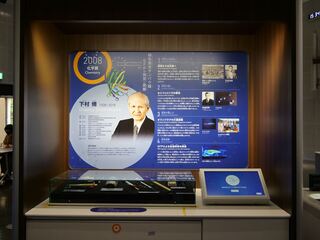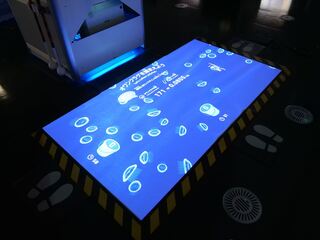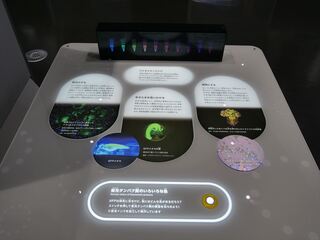Nagoya City Science Museum
TOP > Exhibition Guide > Keyword Search > Starting with "G" > gene > Osamu Shimomura
Osamu Shimomura



Purpose of Exhibition
Dr. Osamu Shimomura was awarded the Nobel Prize in Chemistry in 2008 “for the discovery and development of the green fluorescent protein, GFP” in the jellyfish Aequorea victoria. GFP can be incorporated into the genome of any organism as a marker that emits light in the body of the organism. For this reason, it is now possible to observe various phenomena in the bodies of living organisms over time while the cells and organisms remain alive. GFP has become an essential tool in current life science research.
Additional Knowledge
Dr. Shimomura dedicated his life’s work to unraveling the chemical mechanism behind luminescent creatures.
During his time as a researcher at Nagoya University, he succeeded in crystallizing luciferin, a luminous substance, from the sea firefly, Vargula hilgendorfii. He then began researching the blue luminous Aequorea jellyfish at Princeton University in the United States. He eventually discovered the luminous substance Aequorin in this jellyfish and determined its structure. In the course of his study of Aequorin, GFP was discovered as a by-product.
Dr. Shimomura and his jellyfish collection
Dr. Shimomura studied Aequorin over a 19-year period at Friday Harbor in the northwestern United States, where he collected up to 850,000 Aequorea jellyfish for his research. In this experiential exhibit, “Let’s collect jellyfish” you are introduced to jellyfish harvesting through video. Very little Aequorin is actually obtained from a jellyfish, so you can see how much effort Dr. Shimomura put into his research. These jellyfish typically do not glow unless stimulated. When an attempt is made to catch one with a net, the jellyfish will momentarily glow green. This phenomenon is reproduced in the exhibit.
Discovery of GFP and bioimaging
After Dr. Shimomura discovered GFP, Dr. Martin Chalfie discovered that GFP emits light in living nematodes. Moreover, Dr. Roger Y. Tsien mutated the GFP gene to create a variety of fluorescent colors besides the original green. These two doctors were awarded the Nobel Prize together with Dr. Shimomura.
Bioimaging is a technique for observing phenomena in the bodies of living organisms. The world of bioimaging has grown significantly since the discovery of GFP. By incorporating the GFP found in jellyfish into the genes of other organisms, it is possible to visualize the workings of the genes in the bodies of those living organisms. Before the discovery of GFP, it was not possible to visualize such biological phenomena in living organisms. This exhibit provides an introduction to the world of bioimaging, which greatly expanded with the discovery of GFP.
Dr. Shimomura and the Nobel Prize
This exhibit dedicated to Dr. Shimomura presents the tools he used in his experiments as well as books related to his research. We invite you to take a look at these valuable materials, which include the self-made pipettes he used in his experiments, replicas of notebooks documenting the discovery of GFP, and the biography that Nobel laureates are required to submit to the Nobel Foundation.
* A Fascination with Luminous Jellyfish: The Origin of the Nobel Prize in Chemistry (2009), Osamu Shimomura, Asahi Shimbun Publications Inc.
Luminous Pursuit: Jellyfish, GFP, and the Unforeseen Path to the Nobel Prize (2017), Osamu Shimomura, Sachi Shimomura, John H. Brinegar, World Scientific
* Note: Titles of books and articles above published only in the Japanese language are translated for convenience.
